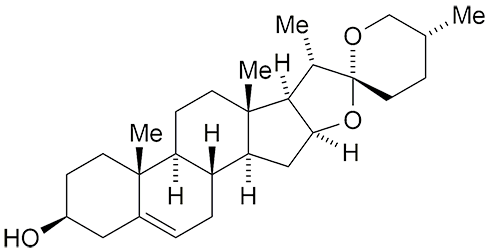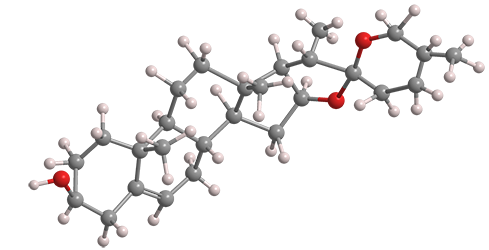What molecule am I?


Diosgenin is a phytosteroid sapogenin isolated from a variety of botanicals. The main source is the genus Dioscorea, tropical wild yam species of the genus Dioscorea that are native to Asia and are now cultivated in other continents. The compound has been known since at least 1936, when Takeo Tsukamoto and Yoshio Ueno at the Pharmaceutical Institute of Kanazawa Medical School (Japan; now part of Kanazawa University) produced it via acid hydrolysis of the glycoside dioscin1, obtained from the species D. tokoro. In subsequent articles, Tsukamoto and Ueno described the structure and properties of diosgenin.
Diosgenin is mainly used to synthesize other steroidal compounds, such as the sex hormones progesterone2 and testosterone3, and the corticosteroids cortisone4 and cortisol5. In the past 20 years, however, it has also been shown to have direct pharmaceutical benefits, including activity against metabolic diseases, inflammatory diseases, and cancer.
Two detailed reviews of the progress of diosgenin in medicine appeared in the past decade: “Diosgenin: Recent Highlights on Pharmacology and Analytical Methodology” by Eugenia Gallardo, Samuel Silvestre, and coauthors at the University of Beira Interior (Covilhã) and the University of Coimbra (both in Portugal) (2016); and “Diosgenin: An Updated Pharmacological Review and Therapeutic Perspectives” by Prabhakar Semwal at Graphic Era University (Dehradun, India); Jarad Sharifi-Rad at Shahid Beheshti University of Medical Sciences (Tehran) and the University of Azuay (Cuenca, Ecuador); William C. Cho at Queen Elizabeth Hospital (Kowloon, Hong Kong); and 12 coauthors at these and 11 other institutions (2022).
1. CAS Reg. No. 19057-60-4.
2. CAS Reg. No. 57-83-0.
3. CAS Reg. No. 58-22-0.
4. CAS Reg. No. 53-06-5.
5. CAS Reg. No. 50-23-7.
Diosgenin hazard information
| Hazard class* | GHS code and hazard statement |
|---|---|
| Not a hazardous substance or mixture |
*Globally Harmonized System (GHS) of Classification and Labeling of Chemicals.
MOTW updates
trans-Cinnamaldehyde1 was the Molecule of the Week for October 28, 2019. A constituent of cinnamon oils, it is an important food flavoring and perfume odorant. Earlier this month, Chen Jin, Zong-yi Wu, Lei Yang, and co-workers at Wenzhou Medical University (China) and Key Laboratory of Orthopedics of Zhejiang Province (Wenzhou) reported that trans-cinnamaldehyde has a beneficial health effect. They found that the compound alleviates bone loss by targeting oxidative stress and mitochondrial damage via the nuclear factor erythroid 2–related factor 2/HO-1 signaling pathway in bone marrow mesenchymal stem cells and ovariectomized mice.
Vanillin2 was the Molecule of the Week for September 13, 2016. The major flavor component of vanilla, it occurs in nature in vanilla beans (primarily Vanilla planifolia), but almost all commercial vanillin is synthetic. Like trans-cinnamaldehyde, cited above, vanillin was shown this month to have an unexpected biological effect. Shunlin Zheng and collaborators at Sichuan Agricultural University (Chengdu, China) and other Chinese institutions, in a 10-year study, found a negative correlation between potato yield and continuous cropping years. They discovered that the decline in adventitious potato root numbers was primarily the result of soil vanillin accumulation.
6PPD3—full name N1-(1,3-dimethylbutyl)-N4-phenyl-1,4-benzenediamine—was a Molecule from the Journals for May 2, 2022. An antioxidant and antiozonant additive in rubber tires, its ozonation product 6PPDQ4 contributes to the die-off of coho salmon and other commercial fish as the result of stormwater runoff from roads into streams. This month, the US Environmental Protection Agency agreed to hear a petition from three West Coast Indigenous people’s tribes that called for the agency to regulate the use of 6PPD in tires. Coho salmon are central to the economies and diets of the tribes and other nearby communities.
1. CAS Reg. No. 14371-10-9.
2. CAS Reg. No. 121-33-5.
3. CAS Reg. No. 793-24-8.
4. CAS Reg. No. 2754428-18-5.
This molecule was suggested by a reader. We present almost all of the molecules suggested by our readers. If you have a molecule you would like us to consider, please send us a message. And thank you for your interest in Molecule of the Week! —Ed.
Diosgenin fast facts
| CAS Reg. No. | 512-04-9 |
| SciFinder nomenclature | Spirost-5-en-3-ol, (3β,25R)- |
| Empirical formula | C27H42O3 |
| Molar mass | 414.62 g/mol |
| Appearance | White crystals or powder |
| Melting point | 205–210 °Ca |
| Water solubility | <1 g/L (25 °C) |
a. Melting points throughout this range are reported.

Learn more about this molecule from CAS, the most authoritative and comprehensive source for chemical information.
Molecule of the Week needs your suggestions!
If your favorite molecule is not in our archive, please send us a message. The molecule can be notable for its current or historical importance or for any quirky reason. Thank you!
Stay Ahead of the Chemistry Curve
Learn how ACS can help you stay ahead in the world of chemistry.

